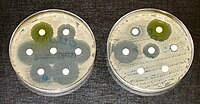
Photo from wikipedia
Knowledge of antibiotic resistance mechanisms is absolutely necessary to successfully fight against multi-resistant bacteria, the solutions to this issue being a direct consequence of understanding the mechanisms underlying its occurrence.… Click to show full abstract
Knowledge of antibiotic resistance mechanisms is absolutely necessary to successfully fight against multi-resistant bacteria, the solutions to this issue being a direct consequence of understanding the mechanisms underlying its occurrence. Considering that in Romania more than 92.3% of patients have been receiving antimicrobial prophylaxis in surgery for more than one day, and empirical therapy is very common, the increasing antibiotic resistance is an important problem. The experiments were performed at the Military Medical Research Center on the 26 multiple drug resistance (MDR) bacterial strains from health care-associated infections (HAI): Escherichia coli (3), Klebsiella spp. (4), Pseudomonas aeruginosa 10), Proteus mirabilis (1), Staphylococcus aureus (7) and Enterobacter cloacae (1). They were isolated and initially identified by the Medical Analysis Laboratory of the Dr. Al. Gafencu Emergency Military Hospital, Constanta and the Microbiology Laboratory from the Military Medical National Institute for Research and Development Cantacuzino of Bucharest. Bacterial strains were reseeded on specific culture media, and identification was based on culture, morpho-tinctorial characters and biochemical properties. Antibiotic susceptibility testing was performed by the Kirby-Bauer diffusion method, following the CLSI 2016 guidelines. The results obtained lead to the idea of reconsidering the strategy for the use of antimicrobial substances by the following actions: performing in vitro sensitivity tests, close collaboration between the clinician and microbiologist, finding additional methods for assessing the effective concentrations of the antibiotic at the level of the infections. The observed percentage of antibiotic resistance in our study was 85.72%, that being much higher than the mentioned percentage by the European Antibiotic Surveillance Report (EARS-Net) for Romania in 2013 (25-50%).
Journal Title: Revista de Chimie
Year Published: 2019
Link to full text (if available)
Share on Social Media: Sign Up to like & get
recommendations!